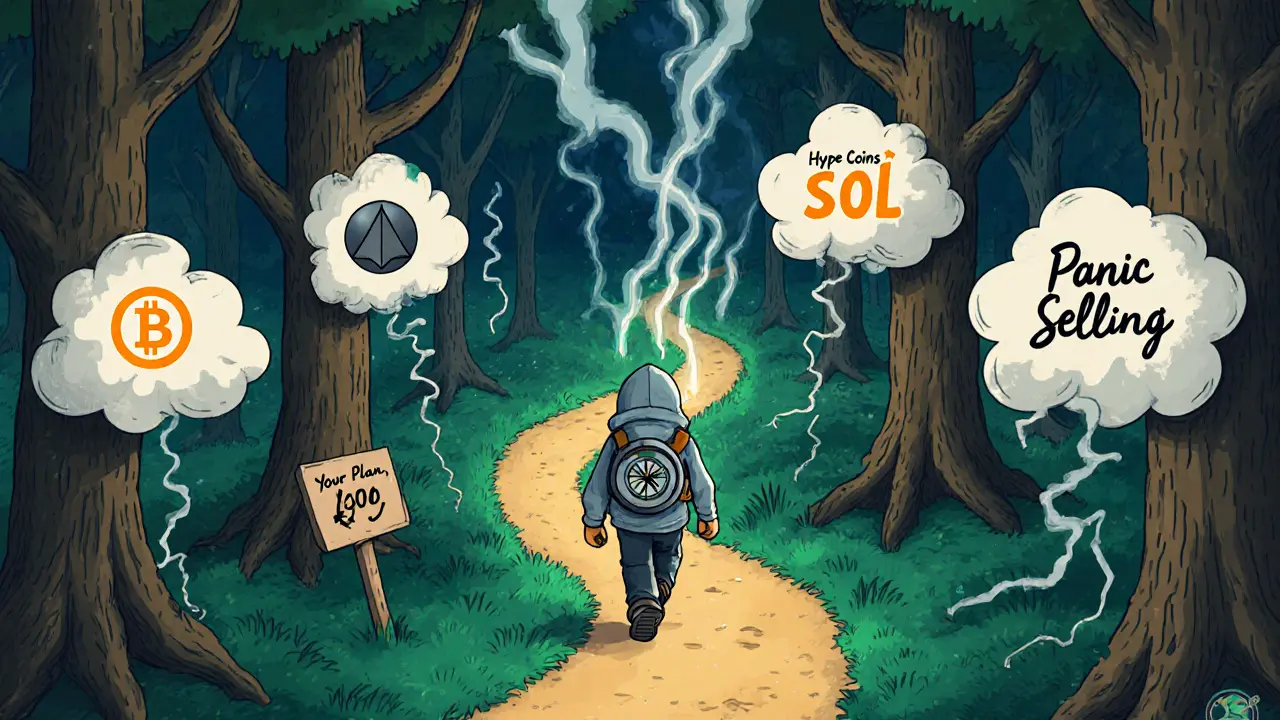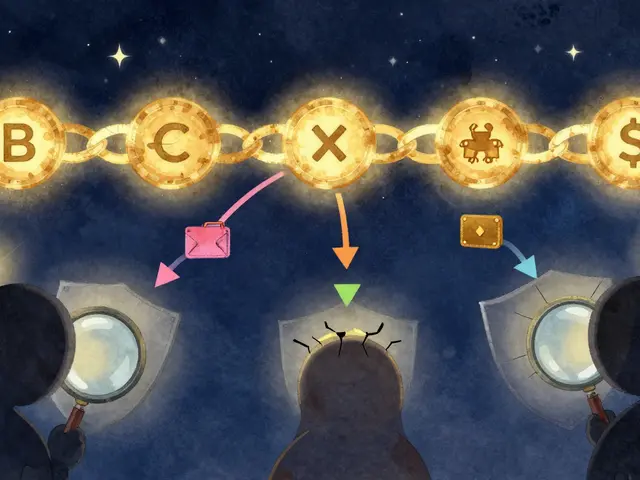Crypto Portfolio Allocation Calculator
Input Your Portfolio Details
Your Optimal Portfolio Allocation
Recommendations
Key Insight: Your portfolio is aligned with the optimal 60-30-10 framework recommended for 2025.
Managing a crypto portfolio in 2025 isn’t about watching price charts all day. It’s about having a system. If you’re holding Bitcoin, Ethereum, or a dozen altcoins across five different wallets and exchanges, you’re probably stressed, confused, or losing money without realizing it. The good news? You don’t need to be a finance expert. You just need a clear plan, the right tools, and the discipline to stick with it.
Why Your Crypto Portfolio Needs Structure
In 2023, most crypto investors were just holding whatever coin caught their eye. By 2025, the market has changed. The total crypto market cap hit $4.2 trillion. That’s not a game anymore-it’s a real asset class. And like any serious investment, it needs structure. Without a plan, you’re gambling. You buy when everyone’s excited, sell when prices crash, and end up buying high and selling low. That’s the exact opposite of how wealth builds. A structured portfolio gives you three things: clarity, control, and confidence. You know exactly what you own, why you own it, and what to do when the market moves. It turns chaos into strategy.The 60-30-10 Allocation Framework That Works
The most reliable portfolio structure in 2025 follows a simple rule: 60% core assets, 30% altcoins, 10% stablecoins. - 60% Core Assets: Bitcoin and Ethereum. These aren’t just coins-they’re the foundation. Bitcoin is digital gold. Ethereum is the backbone of DeFi, NFTs, and smart contracts. Together, they make up over 70% of the total market cap. Most institutional investors start here. - 30% Altcoins: These are your growth engines. Think Solana, Cardano, Polkadot, or established mid-cap tokens with real usage. Don’t chase memes. Look for projects with active development, strong communities, and clear use cases. Holding more than 15 altcoins? You’re over-diversifying. Studies show portfolios with 10-15 assets perform better than those with 30+. - 10% Stablecoins: USDC, USDT, or DAI. These aren’t for profit-they’re for safety. When Bitcoin drops 20% in a week, stablecoins let you sit tight without panic-selling. They also earn yield in DeFi protocols, giving you passive income while you wait for the next bull run. This isn’t magic. It’s math. Portfolios using this model had 38% lower drawdowns during the 2024 market correction, according to Blockchain Capital. And they still captured 89% of the upside when prices rebounded.How Much Bitcoin Should You Own?
Bitcoin is the anchor. The more volatile your portfolio, the more you need it. - Conservative investors: 50-70% Bitcoin, 20-30% Ethereum, 10-30% stablecoins. - Balanced investors: 40% Bitcoin, 30% Ethereum, 20% mid-cap altcoins, 10% stablecoins. - Aggressive investors: 25% Bitcoin, 25% Ethereum, 30% altcoins, 20% speculative tokens. Material Bitcoin’s 2025 analysis shows that passive investors who kept 50-80% in Bitcoin outperformed those chasing every new coin. Why? Bitcoin has the lowest correlation to other assets. It’s your shock absorber. And here’s a real example: If you’d invested $1,000 in Bitcoin in early 2015 at $300 per coin, you’d have about $350,000 by May 2025. That’s a 366x return. You didn’t need to trade. You just needed to hold.Dollar-Cost Averaging: The Quiet Winner
Trying to time the market? You’re losing. The data is clear: 87% of active traders underperform the market over three years, according to Coinbase. Instead, use dollar-cost averaging (DCA). Buy a fixed amount-say $50 or $100-every week or month, no matter the price. It removes emotion. It smooths out volatility. And it works. In 2025, most top portfolio tools like Zerion and GoodCrypto have built-in DCA automation. Set it once, forget it. Over time, you’ll own more coins when prices are low and fewer when they’re high. That’s the essence of smart investing.
Rebalancing: Don’t Let Your Portfolio Drift
Your portfolio doesn’t stay balanced on its own. If Bitcoin spikes 40% in a month, your 60% allocation might become 75%. That’s riskier than you planned. Rebalancing means selling some of what’s grown and buying more of what’s fallen. Do it quarterly-or when any asset moves more than 10% from its target. Institutional portfolios use this rule 73% of the time. One trader on Twitter, @CryptoGains88, turned $5,000 into $87,000 in 28 months by rebalancing every three months. He didn’t predict the market. He just stuck to his plan.Tools You Actually Need
You don’t need five apps. You need one good one. The top three portfolio trackers in 2025:- GoodCrypto (1.9 million users): Best for automation, tax reporting, and DeFi tracking. 4.7/5 rating on Trustpilot.
- Zerion (3.2 million users): Clean interface, strong wallet sync, great for beginners.
- CoinStats (2.7 million users): Simple, fast, and reliable for basic tracking.
The Hidden Problem: Tax Complexity
Every trade, swap, or staking reward is a taxable event. And if you’re using multiple exchanges and wallets, it’s a nightmare. CoinLedger’s 2025 survey found 31% of users had incorrect tax reports because their tools couldn’t track complex DeFi transactions. That’s a big risk. Solution? Use a tracker that supports:- On-chain transaction decoding
- DeFi protocol integration (Uniswap, Compound, Aave)
- Multi-jurisdiction tax rules

What to Avoid
Here are the three biggest mistakes crypto investors make in 2025:- Over-diversifying: Holding 30+ coins doesn’t reduce risk-it dilutes returns. Stick to 10-15 assets max.
- Chasing hype: If a coin has no real use, no team, and no community, it’s speculation-not investment.
- Ignoring stablecoins: Not having cash on hand during a crash forces you to sell at the bottom. Stablecoins are your emergency fund.
How Much Time Should You Spend?
You don’t need to monitor your portfolio daily. Successful investors spend 3-5 hours a week:- 1 hour checking performance
- 1 hour reviewing news or updates on key holdings
- 1 hour planning rebalancing or DCA adjustments
- 2 hours learning-reading one whitepaper, watching a DeFi tutorial, or studying market trends
Final Rule: Write It Down
The most successful investors don’t rely on memory. They write down their rules. Create a one-page plan:- My target allocation: 60% BTC, 30% ETH, 10% stablecoins
- My rebalance trigger: ±10% from target
- My DCA amount: $75 every Friday
- My exit rule: Sell altcoins if they drop 50% from peak and show no development
What’s Next in 2026?
The future of crypto portfolio management is smarter, not harder. AI tools like Portifee are starting to suggest automatic rebalancing based on your risk profile. Binance’s “Smart Portfolio” gives AI-driven allocation tips. By 2026, 65% of trackers will analyze your on-chain behavior to personalize advice. But the core won’t change. You still need a plan. You still need discipline. You still need to avoid emotion. The tools are better. The data is clearer. The market is bigger. Now it’s up to you to use it right.What’s the best crypto portfolio allocation for beginners?
For beginners, start with 60% Bitcoin, 30% Ethereum, and 10% stablecoins. This keeps your portfolio simple, reduces risk, and gives you exposure to the two most established blockchains. Avoid altcoins until you understand how to evaluate them. Use dollar-cost averaging to buy in slowly and avoid timing the market.
Do I need to track my crypto portfolio if I only hold Bitcoin?
Yes. Even if you only hold Bitcoin, you still need to track it. Why? Because you need to know your cost basis for taxes, your purchase history for rebalancing, and your overall performance over time. Many people think they’re doing fine because Bitcoin went up-but they bought at $70,000 and now it’s at $90,000. They think they made money, but they actually lost money compared to buying at $30,000. Tracking gives you real context.
Should I use a crypto portfolio tracker or a spreadsheet?
Use a dedicated tracker. Spreadsheets work for simple portfolios with one exchange, but they fail with DeFi, multi-wallet setups, or frequent trades. Tools like GoodCrypto and Zerion auto-sync with 45+ exchanges and wallets, update prices in real time, and calculate taxes correctly. A spreadsheet can’t handle that. If you’re serious about managing your crypto, invest in the right tool.
How often should I rebalance my crypto portfolio?
Rebalance quarterly, or when any asset moves more than 10% from your target allocation. Rebalancing too often (weekly or monthly) leads to high fees and tax consequences. Rebalancing too rarely lets your portfolio become too risky. Quarterly is the sweet spot-it gives you time to let trends play out without letting your allocation drift too far.
Are stablecoins really necessary in a crypto portfolio?
Yes. Stablecoins act as your shock absorber. When Bitcoin drops 30%, you don’t have to sell your coins to cover expenses or buy more at the bottom. You can just move part of your portfolio into USDC or USDT and wait. They also earn yield in DeFi protocols, giving you 3-8% annual returns with almost no risk. Not having stablecoins means you’re forced to make emotional decisions during market crashes.
Can I manage my crypto portfolio without paying for software?
You can start for free with CoinStats or Zerion’s basic plans. But if you’re holding more than $10,000, using multiple wallets, or doing DeFi trades, you’ll quickly hit limits. Free tools often lack tax reporting, DeFi sync, or multi-chain support. Paying $5-10/month for GoodCrypto or Zerion Pro saves you hours of manual work and avoids costly tax errors. It’s a small price for peace of mind.







Anthony Allen
November 4, 2025 AT 08:39Been using the 60-30-10 split since last year and it’s been a game changer. No more panic selling when BTC dips. I just let it ride and rebalance quarterly. Stablecoins are my secret weapon-earn 5% APY on USDC while waiting for the next pump. Seriously, if you’re not using them, you’re leaving money on the table.
Also, DCA every Friday like clockwork. No thinking. Just automate and forget. Life’s too short to stare at charts.
Tool tip: GoodCrypto’s tax reports saved my ass during audit season. Worth every penny.
Megan Peeples
November 4, 2025 AT 09:24Ugh. I can’t believe people still buy into this ‘structured portfolio’ nonsense. It’s just Wall Street propaganda repackaged for crypto bros. Bitcoin isn’t ‘digital gold’-it’s a speculative bubble with a cult following. And stablecoins? They’re just centralized tokens backed by… what? A bank account? LOL.
Real investors don’t need ‘frameworks.’ They read the whitepapers, trace the on-chain activity, and short the hype. If you’re trusting a 60-30-10 rule, you’re already behind.
Also, Zerion? That app is a data leak waiting to happen. I use a custom Python script. Because I’m not a sheep.
Sarah Scheerlinck
November 6, 2025 AT 03:12I really appreciate how practical this is. I’m a new investor and I was drowning in info before this. The 60-30-10 breakdown made it feel manageable.
Also, the part about writing down your rules? That’s so simple but so powerful. I printed mine and taped it to my monitor. Every time I feel the urge to buy some random memecoin, I look at it and take a breath.
Thanks for reminding me that investing isn’t about speed-it’s about staying calm. I’m going to try DCA this week. Just $25 a week. Baby steps.
karan thakur
November 7, 2025 AT 23:52This is a government and bank propaganda piece disguised as financial advice. The entire crypto market is manipulated by the Fed and Wall Street. Bitcoin is a trap to lure the poor into digital debt slavery. Stablecoins? They’re just digital dollars. The same system you’re trying to escape.
Why are you trusting a tool like GoodCrypto? Who owns it? Who controls the servers? You think they’re not logging your wallet addresses? They’re selling your data to the NSA.
Real freedom means holding your keys offline. No trackers. No apps. No rules. Just cold storage and silence.
Evan Koehne
November 9, 2025 AT 19:36Oh wow. A 366x return on Bitcoin? Wow. I guess I should’ve bought in 2015. Too bad I was busy being a teenager who thought ‘Bitcoin’ was a type of pizza.
But hey, if you’re still holding Bitcoin in 2025 because ‘it’s digital gold,’ congrats. You’re basically a 1990s dot-com investor who still believes in Pets.com.
Also, ‘rebalancing quarterly’? That’s the crypto equivalent of folding your socks before putting them in the drawer. Cute. But does it actually matter? Or are we just pretending to be grown-ups?
Vipul dhingra
November 10, 2025 AT 19:5160 30 10 is for noobs. Real investors go all in on one coin and hold till moon. Why split when you can go all in on Solana or Polygon or even Doge? You think BTC is the only one that can moon? LOL. You’re stuck in 2021 thinking.
Also DCA? That’s for people who can’t read charts. If you can’t time the market you’re not trying hard enough. I bought BTC at 30k and sold at 100k in 2 weeks. That’s how you win.
Stablecoins are for cowards. If you’re scared of volatility you shouldn’t be in crypto. Go buy bonds.
Jacque Hustead
November 11, 2025 AT 18:14This is exactly the kind of clear, calm advice I needed. I’ve been overwhelmed trying to juggle 12 wallets and 3 apps. I’ve been using CoinStats for a while but I didn’t realize how much I was missing with DeFi. I’m upgrading to Zerion this week.
Also, the part about writing down your rules? I’m doing that tonight. I’ve been making emotional trades and I hate that about myself. This feels like a reset button.
Thank you for not making this feel like a cult. It’s refreshing.
Wendy Pickard
November 12, 2025 AT 11:40Just wanted to say thank you for not saying ‘to the moon’ once. It’s so rare to see real advice without the hype.
I’ve been holding Bitcoin since 2021 and never touched my altcoins. I didn’t even know about the 60-30-10 split until now. I’m going to adjust my portfolio this weekend. Small changes, but they matter.
Also, the tax warning? I had no idea DeFi swaps counted as taxable events. That’s scary. I’m installing GoodCrypto tomorrow.
Jeana Albert
November 12, 2025 AT 22:57THIS IS THE WORST ADVICE I’VE EVER READ. YOU’RE TELLING PEOPLE TO PUT 60% IN BITCOIN? WHAT IF IT DROPS 80% AGAIN? WHAT IF THE GOVERNMENT BANS IT? WHAT IF THE BLOCKCHAIN CRASHES? WHAT IF THE SUN GOES OUT?
I LOST $120K LAST YEAR BECAUSE I TRUSTED ‘STRUCTURED PORTFOLIOS.’ NOW I ONLY HOLD PHYSICAL GOLD AND CASH. YOU THINK YOU’RE BEING SMART? YOU’RE JUST ANOTHER SHEEP IN A DIGITAL FLOCK.
AND WHY ARE YOU PROMOTING ZERION? DID THEY PAY YOU? I SAW A POST ON 4CHAN THAT SAID THEY’RE A FRONT FOR THE FBI.
Natalie Nanee
November 13, 2025 AT 08:16It’s funny how people treat crypto like it’s a science. It’s not. It’s a social experiment. The ‘60-30-10’ rule? That’s just a placebo. You’re not investing-you’re performing.
And don’t get me started on DCA. It’s just a way to make yourself feel better while you slowly lose money to inflation.
Real wealth is in land. In cash. In skills. Not in a digital ledger controlled by a handful of devs and venture capitalists.
But hey, if you want to believe in digital gold, go ahead. I’ll be here, watching from the sidelines.
Angie McRoberts
November 15, 2025 AT 05:20One sentence: DCA and rebalance. That’s it. Everything else is noise.
Just do it. No need to overthink. No need to argue. Just set it and forget it. You’ll thank yourself in 2027.
Chris Hollis
November 15, 2025 AT 16:4260-30-10? That’s just a lazy heuristic. No real investor uses fixed allocations. Markets evolve. Your portfolio should too.
Also, ‘Bitcoin is digital gold’ is the most tired phrase in crypto. It’s not gold. It’s a volatile asset with a cult. And stablecoins? They’re just IOUs with higher fees.
Tool recommendation: Don’t use any tracker. Just export your transaction history and use a script. You’ll learn more that way.
And stop pretending this is investing. It’s gambling with better UX.
gerald buddiman
November 17, 2025 AT 14:37Man, I just read this whole thing and I felt… calm? Like, I’ve been running in circles for months trying to ‘maximize returns’ and it’s been pure chaos.
But this? This feels like someone handed me a map. Not a magic wand. Just a map.
I’m gonna start with DCA. $50 a week. No more FOMO buys. No more checking my portfolio every 10 minutes.
And I’m writing my one-page plan tonight. I think I’ve been avoiding it because I was scared I’d get it wrong.
Turns out, getting it ‘right’ isn’t the point. Sticking to it is.
Kyung-Ran Koh
November 17, 2025 AT 19:02Excellent breakdown. I appreciate the precision in the allocation percentages and the emphasis on tax compliance. Many overlook the legal ramifications of DeFi activity, which can lead to severe penalties.
I would add: always verify that your tracker supports EVM-compatible chains (e.g., Arbitrum, Optimism) and that it distinguishes between staking rewards and airdrops-these are taxed differently in the U.S.
Also, consider using a hardware wallet like Ledger for your core assets. No app, no matter how secure, replaces physical control.
Matthew Gonzalez
November 19, 2025 AT 04:48It’s funny how we treat money like it’s a game of chess when it’s really a game of patience.
We think we need complex systems, fancy tools, and perfect timing. But the truth? The best strategy is the one you can stick to when you’re tired, scared, or broke.
That’s why writing it down works. Not because it’s smart. Because it’s human.
And maybe that’s the real innovation-not the tech, but the discipline.
John Doe
November 19, 2025 AT 14:11Everyone’s talking about tools and allocations like it’s some kind of secret society. But let’s be real-this whole system is rigged. The ‘top trackers’ are all owned by venture firms with ties to exchanges. They’re not helping you-they’re harvesting your data to front-run your trades.
And DCA? That’s just a way for the market makers to slowly suck your money into their liquidity pools.
I don’t track anything. I hold my keys. I read the code. I trust no one. That’s the only way to win.
Ryan Inouye
November 21, 2025 AT 00:18Why are Americans so obsessed with ‘structure’? In Europe we just buy what we like and hold. No rules. No spreadsheets. No ‘frameworks.’
This post reads like a corporate training manual. Who wrote this? A financial advisor who just got into crypto last year?
Also, Bitcoin is not ‘digital gold.’ It’s a speculative asset. And stablecoins? They’re just USD with a blockchain sticker.
Stop pretending this is investing. It’s entertainment.
Rob Ashton
November 21, 2025 AT 01:20Thank you for presenting this information with such clarity and professionalism. Your structured approach aligns with the principles of prudent long-term capital management.
I would respectfully suggest that readers also consider the impact of regulatory developments in the EU and Asia, as cross-border tax implications may vary significantly from U.S. guidelines.
Additionally, the recommendation to use reputable custodial solutions is not merely advisable-it is a fiduciary responsibility for any investor holding significant assets.
Cydney Proctor
November 21, 2025 AT 04:32Oh please. This is the most basic, watered-down, ‘safe for work’ advice I’ve ever seen. You’re telling people to put 60% in Bitcoin? In 2025? With the halving already priced in? With ETFs saturating the market?
Real investors are already moving into AI tokens, RWA protocols, and tokenized real estate.
This isn’t advice-it’s a time capsule from 2021. You’re not helping anyone. You’re just comforting the fearful.
Cierra Ivery
November 21, 2025 AT 07:46Wait, so you’re telling me I shouldn’t buy every new coin that trends on Twitter? That I shouldn’t leverage my house to buy Solana? That I shouldn’t join every Telegram group and ‘stack sats’ while screaming ‘TO THE MOON’?
But… but… that’s the whole point!
Also, why are you so obsessed with ‘rebalancing’? Sounds like a boring accountant’s hobby. I want excitement. I want risk. I want chaos.
My portfolio is 90% memecoins. I’m rich. You’re not.
Stephanie Tolson
November 23, 2025 AT 00:14This is the kind of post that makes me believe crypto still has a soul.
I used to think I needed to be a trader to win. Turns out, I just needed to be a patient person.
I’m starting DCA tomorrow. $75 every Friday. No more stress. No more FOMO.
And I’m writing my one-page plan. Not because I’m smart. Because I’m tired of being scared.
Angie Martin-Schwarze
November 24, 2025 AT 19:05so i tried the 60 30 10 thing and then my wallet got hacked and i lost everything so now i just keep my crypto on binance and pray lol
also i dont know what a stablecoin is but i think its like a coin that doesnt change price? i think i have one
and i use a spreadsheet but i think i spelled ‘rebalance’ wrong
also why does everyone keep saying ‘dca’ is it like a coffee?
Anthony Allen
November 25, 2025 AT 09:11Hey @932 - you’re not alone. I lost my first wallet too. That’s why I switched to Ledger + GoodCrypto. The app doesn’t hold your keys, but it tracks everything. And I back up my recovery phrase on a metal plate. No cloud. No phone.
DCA = Dollar-Cost Averaging. It’s not coffee. It’s how you buy crypto without losing your mind.
Start small. $20 a week. You’ll be surprised how much it adds up. And you won’t get hacked if you don’t leave it on an exchange.
Rob Ashton
November 25, 2025 AT 15:10Thank you for the thoughtful response. I would also emphasize that physical backup solutions-such as engraved metal seed phrase plates-are now considered best practice in institutional custody protocols. Digital backups, even encrypted, remain vulnerable to cyber intrusion or human error.
For beginners, I strongly recommend pairing hardware wallets with a multi-signature recovery setup. It adds minimal friction but dramatically increases resilience.